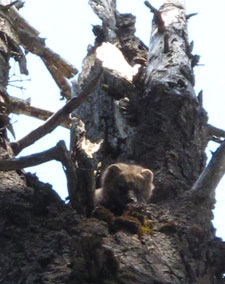The weasel family or the mustelids is a broad group of mammals that in Cascadia includes everything from wolverines to minks and from sea otters to least weasels. As one might suspect with a group this large and diverse, some of these species are generalist and more tolerant of human incursion and therefore doing fairly well, but some are declining or in serious need of protections. Cascadia Wildlands focuses our efforts on those that need the most help and also those whose recovery will provide the greatest ecological benefit.
Nearly hunted out of existence in the eastern Pacific during the height of the fur trade, the sea otter has made some recovery progress in areas—most notably in the northern portions of its range along coastal Alaska. Sea otters are quintessential keystone species and their presence or absence can often mean the difference between have a kelp forest or not. Given the importance of kelp forests as nursery grounds for economically important fish species and kelp’s ability to sequester carbon, broader recovery of otters in terms of numbers and distribution should be a priority.
Wolverines are the largest terrestrial member of the weasel family. In Cascadia they are holding their own in British Columbia and Alaska but their populations in Washington (Northern Cascades), Oregon (Wallowa Mountains) and California (Sierra Nevada Mountains) are extremely low and the reason they are currently proposed for threatened listing under the federal Endangered Species Act (fall 2013).
Wolverines in the more northern reaches of their range exhibit a broader spectrum of habitat uses than they do below the US-Canada border. It is thought that this has more to do with their aversion and sensitivity to human activity than any particular habitat preference. It accentuates the notion that wolverines need wilderness.
Pacific fishers are one of the larger terrestrial members of the weasel family—larger than martens and smaller than wolverines. Although fishers can climb trees, they spend most of their time on the forest floor. Fishers are not habitat generalists as they need large expanses of mixed hardwood or conifer forests with a closed canopy structure. Part of this preference relates to the female’s need for large denning trees but both sexes tend to be found in old growth forests and avoid heavily logged areas dominated by second growth.
Recent posts on this topic:

